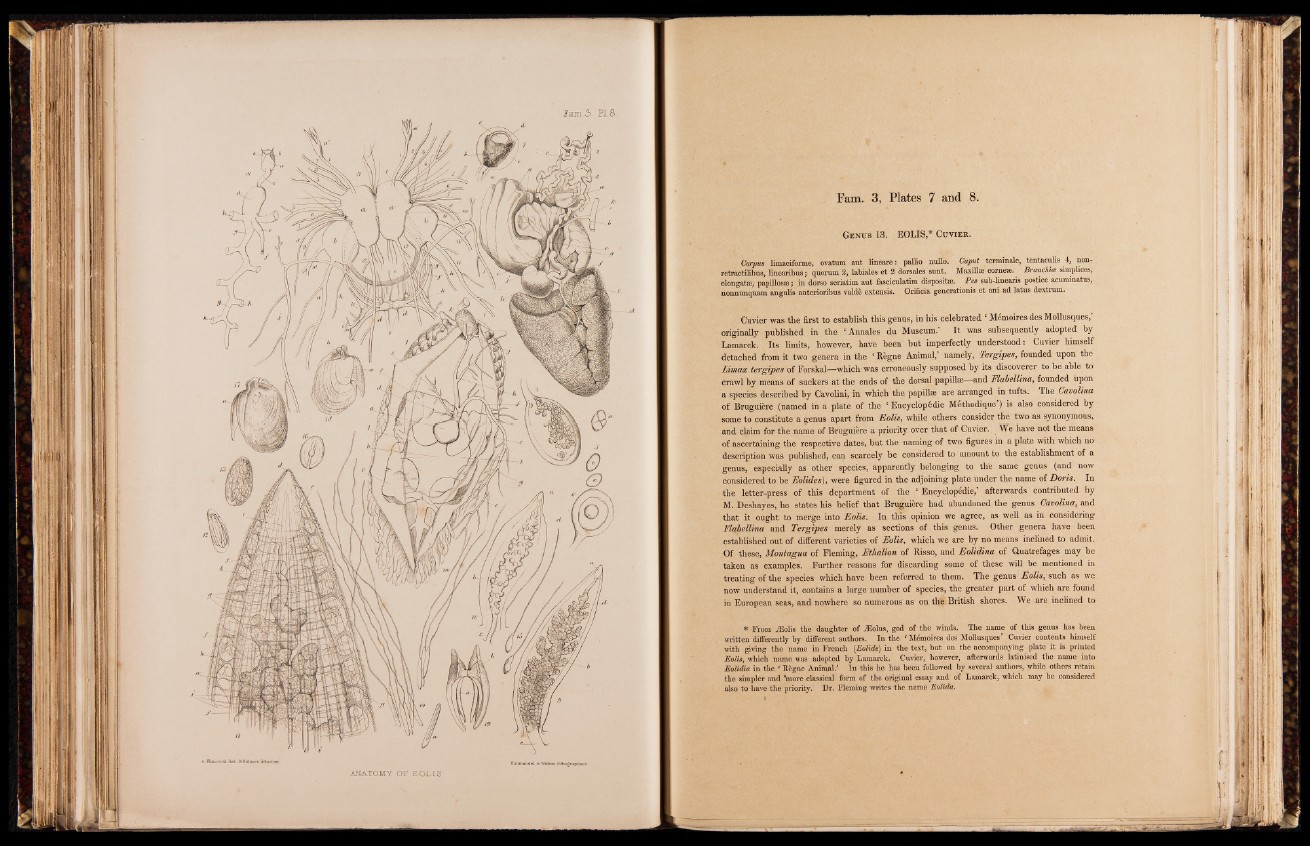
Pam:«3. PI.8.
Genus 13. EOLIS,* Cu v ie r .
Corpus limaciforme, ovatum aut lineare : pallio nullo. Caput terminale, tentaculis 4, non-
retractilibus, linearibus ; quorum 2, labiales et 2 dorsales sunt. Maxillæ corneæ. ^ Branchùe simplices,
elongatæ, papillosæ ; in dorso seriatim aut fasciculatim dispositæ. Pes sub-linearis postice acuminatus,
nonnunquam angnlis anterioribus valdè extensis. Orificia generationis et ani ad latus dextrum.
Cuvier was the first to establish this genus, in his celebrated | Mémoires des Mollusques,’
originally published in the 4 Annales du Museum.’ It was subsequently adopted by
Lamarck. Its limits, however, have been but imperfectly understood: Cuvier himself
detached from it two genera in the 4 Règne Animal,’ namely, Tergipes, founded upon the
Limax tergipes of Forskal—which was erroneously supposed by its discoverer to be able to
crawl by means of suckers at the ends of the dorsal papillae and Flabellina, founded upon
a species described by Cavolini, in which the papillae are arranged in tufts. The Cavolina
of Bruguière (named in a plate of the 4 Encyclopédie Méthodique ) is also considered by
some to constitute a genus apart from Eolis, while others consider the two as synonymous,
and claim for the name of Bruguière a priority over that of Cuvier. We have not the means
of ascertaining the respective dates, but the naming of two figures in a plate with which no
description was published, can scarcely be considered to amount to the establishment of a
genus, especially as other species, apparently belonging to the same genus (and now
considered to be Eolides), were figured in the adjoining plate under the name of Doris. In
the letter-press of this department of the 4 Encyclopédie,’ afterwards contributed by
M. Deshayes, he states his belief that Bruguière had abandoned the genus Cavolina, and
that it ought to merge into Eolis. In this opinion we agree, as well as in considering
Flabellina and Tergipes merely as sections of this genus. Other genera have been
established out of different varieties of Eolis, which we are by no means inclined to admit.
Of these, Montagua of Fleming, Ethalion of Risso, and Eolidina of Quatrefages may be
taken as examples. Further reasons for discarding some of these will be mentioned in
treating of the species which have been referred to them. The genus Eolis, such as we
now understand it, contains a large number of species, the greater part of which are found
in European seas, and nowhere so numerous as on the British shores. We are inclined to
* From Æolis the daughter of Æolus, god of the winds. The name of this genus has been
written differently by different authors. In the f Mémoires des Mollusques Cuvier contents himself
with giving the name in French {Eolide) in the text, but on the accompanying plate it is printed
Eolis, which name was adopted by Lamarck. Cuvier, however, afterwards latinised the name into
Eolidia in the ‘ Règne Animal.’ In this he has been followed by several authors, while others retain
the simpler and *more classical form of the original essay and of Lamarck, which may be considered
also to have the priority. Dr. Fleming writes the name Eolida.